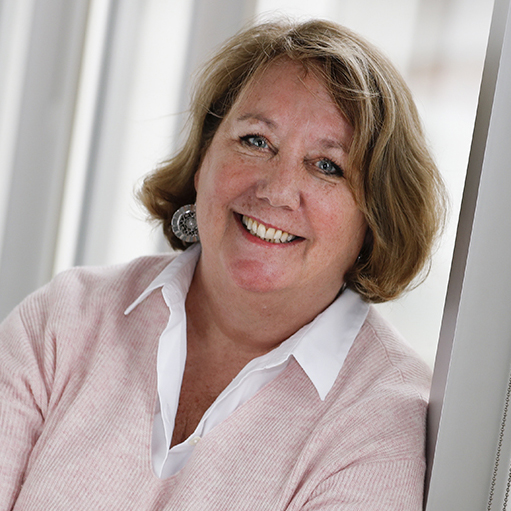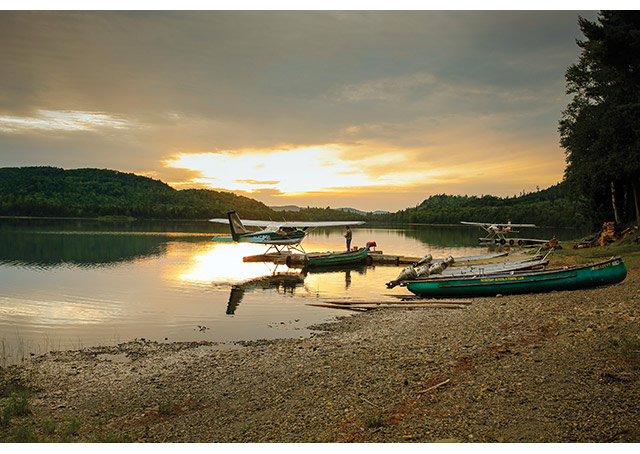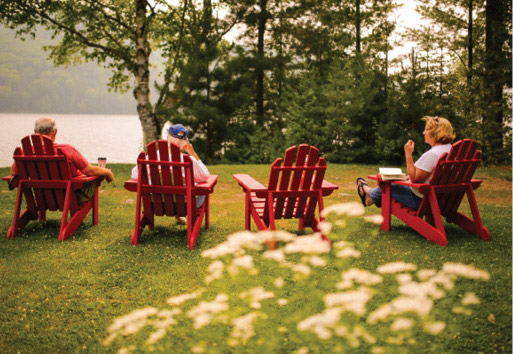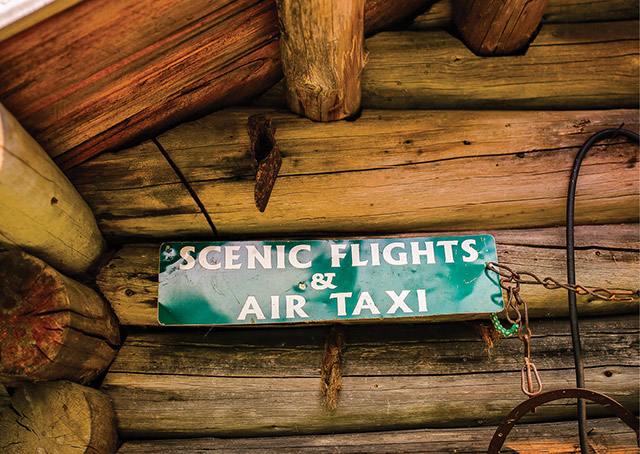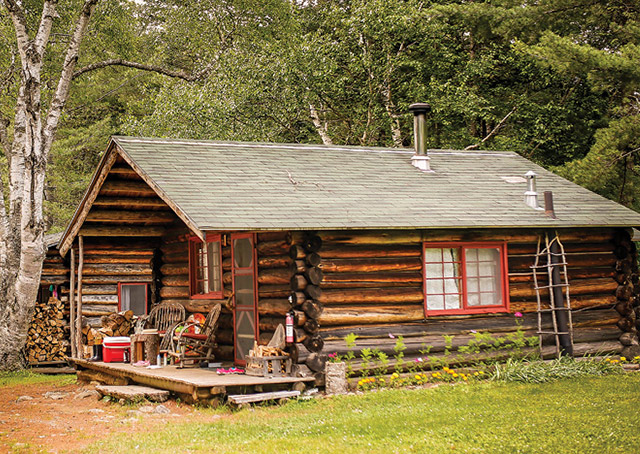Getaways: Sikorsky Weekend
Summer camp
We find Igor Sikorsky III in northern Maine
Deep in the woods of Maine, the grandson of one of the most influential aircraft designers hosts “Sikorsky Weekend” each year, telling tales of his grandfather, Russia before the Bolshevik revolution, and the early days of helicopter design—and taking visitors seaplane flying and fishing. Meet Igor Sikorsky III.
Sikorsky and his wife, Karen, run the 100-year-old Bradford Camps on the shores of Munsungan Lake, a four-mile-long body of pristine water that is home to trout, salmon, and perch. Bradford is a traditional sporting camp, with eight waterfront log cabins—the only inhabited structures in this area of the North Maine Woods. Bradford Camps is located at the center of this 3.5-million-acre natural wonderland, where moose, bears, deer, beavers, eagles, and ospreys are the citizenry.
To get here, one can travel across rugged logging roads for several hours or, more intelligently, by seaplane. Sikorsky will pick you up in his Cessna 172 on floats in Bangor—or veteran Maine seaplane pilot Jim Strang, who operates Katahdin Air Service, can fly you in his 206.
The leisurely Sikorsky Weekend is highlighted by Sikorsky’s talks about his grandfather. Igor Ivanovich Sikorsky made the helicopter viable, and the younger Sikorsky knew his grandfather as a gentle, loving man who led a charmed life. During his fireside talks in the sporting camp lodge, with a massive moose head and equally massive deer head overlooking the room, the entertaining younger Sikorsky shares his grandfather’s years in Russia, the construction of the four-engine Le Grand for the czar, his early years in the United States as a nearly penniless immigrant with big ideas, the Pan Am flying boats, and life as a test pilot building helicopters for United Aircraft (later United Technologies). Rich with original photographs, drawings, and correspondence, the experience is truly a taste of history.
Getting there
Bradford Camps shares history with the early fishing camps frequented by gentlemen travelers of the late eighteenth century. That was an era when men of means would pack trunks full of clothing and life essentials and travel by train, boat, and eventually horse-drawn carriages into the woods to hunt, fish, and commune with nature—a Hemingwayesque version of life.
Yet the life that the younger Sikorsky has made here belies that vision. These are family cabins in an area that Sikorsky hopes to keep pristine and as close to nature as possible. There’s no Wi-Fi in the cabins; certainly no TV, phone lines, or even electric lights. You get your illumination from gaslights you strike yourself—there are matches at each light—or you go to sleep and wait for the sun.
And what a sleep it is. Quiet as only a place so removed from civilization can be; the woods crack with sounds of (hopefully) small critters, waves lap the shore of the lake, and wind rustles the leaves in the trees. Birdsong heralds the start of day. And the bell for breakfast.
Guests at Bradford Camps eagerly await that breakfast bell. There is a private chef for the camps: Tiffany Craig, who loves to use native foods. So there are blueberry pancakes (this is Maine, after all) and real maple syrup. If everyone is lucky, one of the other campers has caught perch or salmon in the lake—or flown out to other, more remote lakes and brought back the catch—and Craig will fry the fish for breakfast. Sikorsky and his wife greet everyone with a hearty good morning and suggestions on how to spend the day.
Many of the guests have flown in by seaplane, so they will spend the day taking off and exploring the other remote lakes and deep woods here. They may see moose swimming in the streams and
rivers. Bear sightings also are possible.
We are entertained by a couple who have brought their granddaughters to the camps for a week. They tell a tale of coming up here years ago, and a young bear swimming out to their seaplane and grabbing onto the strut—as if begging to be taken back to civilization with them. The bear had been one of several raised in captivity after its mother was killed, and the woman must have reminded the bear of the human who raised him. Wagging the wings, the pilot knocked the bear off the strut and dropped him into the lake. The granddaughters find this tale more fascinating than the absent TV.
There are kayaks and fishing boats. A guide will take you on the lake or into the woods: Chad Rozelle and Josh Collins are guides who live at the camps and know the area intimately. Rozelle has worked with the Sikorskys for more than 20 years. Both help stock the cabins with essentials, such as ice from the ice house. You need to bring your own beverages, but the ice is native—it’s chopped from the lake in March or April and stored in sawdust in the ice house. It will stay cold all summer and there will be ice left over.
Helicopters and history. During most of the seven-month season at Bradford Camps, Sikorsky is camp leader, hunting guide, repairman, and escort. But this weekend, usually in July, he sets aside his chores and takes on a role that isn’t particularly comfortable for him—that of lecturer, entertainer, and historian. He sips a little vodka from his coffee mug for liquid courage.
He needn’t worry about his audience. They want to know everything he can tell them about his famous grandfather, the legendary company—and, by the way, why is the grandson of the founder of a multibillion-dollar industry squirreled away in a fishing camp?
The later bit of information is a doozy: Igor Sikorsky III has never flown in a helicopter. In fact, he did not learn to fly fixed-wing aircraft until he was nearly 30. And he learned to fly only because he and Karen needed a way to get to their beloved camps more easily than the overland trek. She wasn’t thrilled at first but, as he told her, “You’re not going to tell Igor Sikorsky he can’t learn to fly.”
That’s as much bravado as you’re going to get from Sikorsky. He clearly inherited his grandfather’s knack for invention as well as his simplicity—this is why the younger Sikorsky isn’t a billionaire on a much-more-accessible private island. Igor Sikorsky made viable the helicopter in America, but when he was approached by United Aircraft for his designs, he asked only for a salary—and for the guaranteed salaries of the other Russian immigrants who had helped him build his helicopter. “He was in debt for most of his career,” the younger Sikorsky says.
Sikorsky escaped Russia before the Russian Revolution because, as an inventor for the czar, he would have been considered a noble. That didn’t end well for most. He came to the United States alone, preparing the way for his wife and daughter. But soon after he arrived, he received a Dear John letter from his wife. She’d met someone else and was staying in Russia—but their daughter was on a ship, bound for America.
Sikorsky later remarried and had four more children, all sons. Igor III is the son of the third son. Old photographs show a respectable and obviously well-to-do family. But Sikorsky did not forget his humble beginnings in the United States, where he and his workers created blades for his helicopter designs from metal slats left over from the war’s hospital cots. He also was a deeply religious man who, toward the end of his life, wrote books about his spiritual journey—and one about his interpretation of the Lord’s Prayer.
“My grandfather had a feeling of destiny,” Sikorsky tells the rapt listeners as a mouse scurries across the lodge floor. “His belief was that this life is a minor stepping stone in the evolution of our souls.”
One visitor for Sikorsky Weekend can barely contain his joy at being here. He clutches a book that he found as a young man, which was signed by Igor Sikorsky. He’s had it signed by Igor Jr. and now wants the grandson to sign it. Peter Curry is a New York City firefighter who was profoundly affected by a biography about Sikorsky. He read it when he was a teenager and has been enamored of the inventor ever since. He has been to the Sikorsky Aircraft facility in Stratford, Connecticut, and visited the memorial office that is still there. “I sat in his chair but didn’t touch his hat,” Curry remembers. Most photos of the era show Sikorsky wearing a stylish fedora on the test flights. “I wish I’d touched the hat.”
Curry’s wife, Ellen, is a banker. The couple lives in Queens. She is the one who found out about Sikorsky Weekend and proudly boasts that her husband knows “everything” about the inventor. They both thoroughly enjoy this step away from civilization—although Curry walks the entire shore while his wife kayaks the massive lake, making sure she stays safe. “He was working September 11,” she confides. He doesn’t elaborate.
The elder Sikorsky lived to see the first spacewalk and meet Neil Armstrong. But the younger Sikorsky thinks his grandfather would have been most gratified by the fact that his helicopters are used for rescue operations. Helicopters were his first love, although he designed fixed-wing aircraft in the United States, most notably a flying boat. “He always believed the helicopter would have its greatest achievements in rescuing people,” the younger Sikorsky says. “That would be the verification of his dream.”
Email [email protected]
